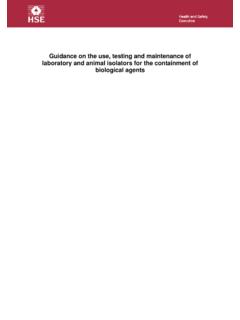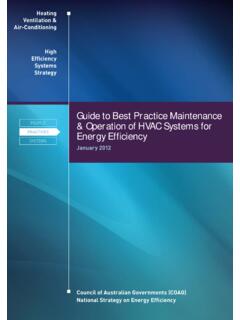Transcription of Operations & Maintenance Best Practices Guide: Release 3
1 FEDERAL energy MANAGEMENT PROGRAM Release Operations & Maintenance Best Practices A Guide to Achieving Operational Efficiency August 2010 Release Operations & Maintenance Best Practices A Guide to Achieving Operational Efficiency G. P. Sullivan(a) R. Pugh A. P. Melendez W. D. Hunt August 2010 Prepared by Pacific Northwest National Laboratory for the Federal energy Management Program department of energy (a) Efficiency Solutions, LLC Disclaimer This report was sponsored by the United States department of energy , Office of energy Efficiency and Renewable energy , Federal energy Management Program. Neither the United States Government nor any agency or contractor thereof, nor any of their employees, makes any warranty, express or implied, or assumes any legal liability or responsibility for the accuracy, completeness, or usefulness of any information, apparatus, product, or process disclosed, or represents that its use would not infringe privately owned rights.
2 Reference herein to any specific commercial product, process, or service by trade name, mark, manufacturer, or otherwise, does not necessarily constitute or imply its endorsement, recommendation, or favoring by the United States Government or any agency or contractor thereof. The views and opinions of authors expressed herein do not necessarily state or reflect those of the United States Government or any agency or contractor thereof. Preface This Operations and Maintenance (O&M) Best Practices Guide was developed under the direction of the department of energy s Federal energy Management Program (FEMP). The mission of FEMP is to facilitate the Federal Government s implementation of sound, cost-effective energy management and investment Practices to enhance the nation s energy security and environmental stewardship. Each of these activities is directly related to achieving requirements set forth in: The energy Policy Act of 2005, which established a number of energy and water management goals for Federal facilities and fleets and also amended portions of the National energy Conservation Policy Act (NECPA).
3 Executive Order 13423, Strengthening Federal Environmental, energy , and Transportation Management (signed in January 2007). This set more challenging goals than EPAct 2005 and superseded existing executive orders 13123 and 13149. The energy Independence and Security Act of 2007, which further established energy , water, and building commissioning management goals and requirements and also amended portions of EPAct 2005 and NECPA. EISA was signed into law in December 2007. Executive Order 13514, Federal Leadership in Environmental, energy and Economic Performance (signed in October of 2009) directs Federal agencies to further address energy , water, and operational efficiency beyond 13423 with targeted goals and actions. Release of this guide provides updates to Release in the areas of O&M technologies, equipment performance, and costs. This new Release also addresses water use and the impacts that recommended O&M Practices can have on water efficiency.
4 Overall, this guide highlights O&M programs targeting energy and water efficiency that are estimated to save 5% to 20% on energy bills without a significant capital investment. Depending on the Federal site, these savings can represent thousands to hundreds-of-thousands dollars each year, and many can be achieved with minimal cash outlays. In addition to energy /resource savings, a well-run O&M program will: Increase the safety of all staff, as properly maintained equipment is safer equipment. Ensure the comfort, health, and safety of building occupants through properly functioning equipment providing a healthy indoor environment. Confirm the design life expectancy of equipment is achieved. Facilitate the compliance with the above-mentioned Acts and Orders as well as Federal legislation such as the Clean Air Act and the Clean Water Act, as well as expected carbon mitigation legislation. The focus of this guide is to provide the Federal O&M/ energy manager and practitioner with information and actions aimed at achieving these savings and benefits.
5 O&M Best Practices Guide, Release iii Acknowledgments This report is the result of numerous people working to achieve a common goal of improving Operations and Maintenance and energy /water efficiency across the Federal sector. The authors wish to acknowledge the contribution and valuable assistance provided by the staff of the Federal energy Management Program (FEMP). Specifically, we would like to thank Ab Ream and Shawn Herrera, FEMP Program Managers, for their leadership and support of the FEMP Operations and Maintenance program. In addition, the authors would like to recognize Bill Sandusky of the Pacific Northwest National Laboratory (PNNL) for his continued commitment and recognition of the resource savings potential of O&M to the Federal sector. Also from PNNL, Eric Richman and Carol Jones, and Hayden McKay of Hayden McKay Lighting Design, Inc. for their work on the Lighting section of this document. Beth Shearer, of Beth Shearer and Associates, provided a conscientious review of material provided in this version of the document.
6 She provided invaluable comments and suggestions to improve the quality of the document. Finally, the authors would like to extend their appreciation to PNNL s document production team Dave Payson and Elaine Schneider for the conscientious, team-oriented, and high quality assistance they brought to this version of the document. O&M Best Practices Guide, Release v Contents iii Acknowledgments .. v Chapter 1 Introduction and About This Guide .. Target Organization and Maintenance of the Chapter 2 Why O&M?.. Introduction .. Definitions .. Motivation .. O&M Potential, energy Savings, and Beyond .. References .. Chapter 3 O&M Introduction .. Developing the Structure .. Obtain Management Support .. The O&M Mission Measuring the Quality of Your O&M Program.
7 Selling O&M to Management .. Program Implementation .. Program O&M Contracting .. O&M Contract Contract Incentives .. O&M: The ESPC O&M Needs for Verified and Persistent Savings .. Determination and Verification of O&M Savings in ESPCs .. References .. Chapter 4 Computerized Maintenance Management System .. Introduction .. CMMS Needs Assessment .. CMMS CMMS Benefits .. CMMS O&M Best Practices Guide, Release vii Contents Chapter 5 Types of Maintenance Programs .. Introduction .. Reactive Maintenance .. Preventive Maintenance .. Predictive Maintenance .. Reliability Centered How to Initiate Reliability Centered Chapter 6 Predictive Maintenance Technologies.
8 Introduction .. Thermography .. of Equipment .. Electrical System Mechanical System Applications .. Roof Studies .. Infrared Service Infrared Internet Resource Sites .. Lubricant and Wear Particle Analysis .. Types .. of Equipment .. Studies .. Analysis Equipment Resources .. Oil Analysis Internet Resource Ultrasonic .. of Equipment .. Pressure/Vacuum Mechanical Electrical Studies .. O&M Best Practices Guide, Release viii Contents Equipment Service Internet Resource Vibration .. of Equipment .. Studies .. Training Equipment Service Training/Internet Resource Motor Analysis.
9 Analysis Electrical Surge Motor Current Signature Analysis .. Equipment Service Internet Site Performance .. to Establish a Performance Trending Studies .. Chapter 7 Commissioning Existing Introduction .. Definitions .. Typical Findings from Existing Building Commissioning .. Tracking Commissioning Benefits .. The Commissioning Process .. Commissioning Provider Qualifications .. The Future of Building Case Shutdown During Unoccupied Recommissioning at a DOE National O&M Best Practices Guide, Release ix Contents Additional Resources .. Chapter 8 Metering for Operations and Maintenance .. Introduction .. Importance of Metering and the Business Metering Applications.
10 Metering Metering Hierarchy .. Metering System Analysis .. Metering Metering Financing Financing Steps in Meter Program Goals and Objectives .. Needs to Support Selected Analysis and Apply Evaluation , Design, and Validation and Case Study General Services Administration s Kastenmeier Federal Courthouse .. Chapter 9 O&M Ideas for Major Equipment Types .. Introduction .. and Boilers .. Introduction .. Fire-Tube Water-Tube Electric Boilers .. Key Components .. Critical Components .. Other Components .. Safety Issues .. Efficiency, Safety, and Life of the Boiler energy Best and energy /Water Efficiency, Safety, and Life of the Boiler energy Best O&M Best Practices Guide, Release x Contents of Tools.














